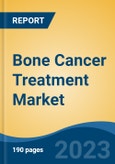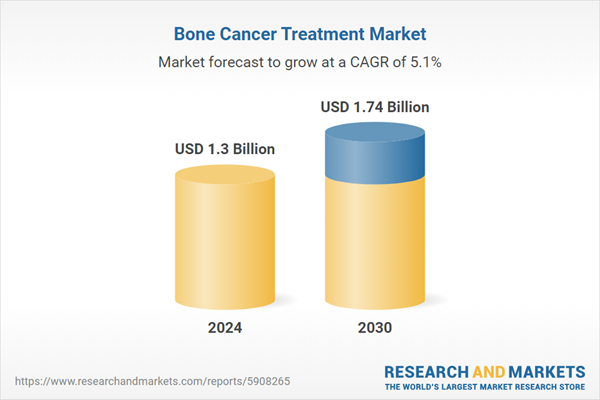Speak directly to the analyst to clarify any post sales queries you may have.
10% Free customizationThis report comes with 10% free customization, enabling you to add data that meets your specific business needs.
Key Market Drivers
Technological Advancements
Technological advancements have played a pivotal role in reshaping the landscape of bone cancer treatment. Modern imaging techniques, such as magnetic resonance imaging (MRI) and positron emission tomography (PET) scans, have revolutionized the diagnosis and staging of bone cancer. These technologies offer unparalleled precision in locating and characterizing tumors, enabling healthcare professionals to make informed decisions about treatment. One of the most significant breakthroughs in bone cancer treatment is the development of targeted therapies. Unlike traditional chemotherapy, which affects both cancerous and healthy cells, targeted therapies focus on specific molecules or pathways within cancer cells.This precision minimizes collateral damage to healthy tissues and reduces the side effects associated with treatment. Technological advancements have also led to the refinement of surgical procedures for bone cancer treatment. Minimally invasive techniques, such as robotic-assisted surgery and laparoscopy, allow for smaller incisions, faster recovery times, and reduced postoperative pain. The emergence of 3D printing technology has transformed the creation of customized prosthetics for bone cancer survivors. These prosthetics are tailored to fit each patient's unique anatomy, providing a higher level of comfort and functionality. This innovation significantly improves the quality of life for individuals who have undergone limb-sparing surgeries.
Key Market Challenges
Limited Research Funding and Resources
One significant challenge faced by the bone cancer treatment market is the relative rarity of bone cancer compared to other types of cancer, such as breast or lung cancer. Because of its lower prevalence, bone cancer research often receives fewer resources and funding allocations. This limitation can impede the development of innovative treatments and therapies specifically tailored to bone cancer. Conducting clinical trials and research related to bone cancer can be financially demanding. The costs associated with patient recruitment, data collection, and the development of new drugs or treatment modalities are substantial. Inadequate funding and resources can hinder the progress of clinical trials and limit the exploration of potential breakthroughs.Key Market Trends
Advancements in Targeted Therapies
One significant trend in the global bone cancer treatment market is the rapid development of targeted therapies. Rather than employing broad-spectrum treatments like chemotherapy, precision medicine is gaining prominence. This approach involves identifying specific genetic mutations or molecular markers unique to an individual's cancer cells. Targeted therapies are designed to precisely target these markers, disrupting the growth and spread of cancer cells while sparing healthy tissues.This trend is improving treatment outcomes and reducing the side effects associated with traditional therapies. Immunotherapy is another burgeoning trend in bone cancer treatment. This approach harnesses the body's immune system to recognize and attack cancer cells. Immunotherapeutic drugs, such as immune checkpoint inhibitors, are being investigated for their potential to enhance the immune response against bone cancer. The development of personalized immunotherapies tailored to each patient's unique immune profile is on the horizon, offering promising avenues for treatment.
Key Market Players
- Amgen Inc
- Baxter Inc
- Bayer AG
- ZetaMet Technology
- Johnson & Johnson
- Novartis AG
- Pfizer Inc.
- Recordati Group
- Takeda Pharmaceutical Company
- Eli Lilly and Company
- Spectrum Pharmaceuticals Inc
Report Scope:
In this report, the Global Bone Cancer Treatment Market has been segmented into the following categories, in addition to the industry trends which have also been detailed below:Bone Cancer Treatment Market, By Bone Cancer Type:
- Primary Bone Cancer
- Secondary Bone Cancer
Bone Cancer Treatment Market, By Treatment Type:
- Chemotherapy
- Targeted Therapy
- Radiation Therapy
- Surgery
- Others
Bone Cancer Treatment Market, By Region:
- North America
- United States
- Canada
- Mexico
- Europe
- France
- United Kingdom
- Italy
- Germany
- Spain
- Asia-Pacific
- China
- India
- Japan
- Australia
- South Korea
- South America
- Brazil
- Argentina
- Colombia
- Middle East & Africa
- South Africa
- Saudi Arabia
- UAE
- Kuwait
- Turkey
- Egypt
Competitive Landscape
Company Profiles: Detailed analysis of the major companies present in the Global Bone Cancer Treatment Market.Available Customizations:
With the given market data, the publisher offers customizations according to a company's specific needs. The following customization options are available for the report.Company Information
- Detailed analysis and profiling of additional market players (up to five).
This product will be delivered within 1-3 business days.
Table of Contents
Companies Mentioned
- Amgen Inc
- Baxter Inc
- Bayer AG
- ZetaMet Technology
- Johnson & Johnson
- Novartis AG
- Pfizer Inc.
- Recordati Group
- Takeda Pharmaceutical Company
- Eli Lilly and Company
- Spectrum Pharmaceuticals Inc
Table Information
| Report Attribute | Details |
|---|---|
| No. of Pages | 184 |
| Published | March 2025 |
| Forecast Period | 2024 - 2030 |
| Estimated Market Value ( USD | $ 1.3 Billion |
| Forecasted Market Value ( USD | $ 1.74 Billion |
| Compound Annual Growth Rate | 5.1% |
| Regions Covered | Global |
| No. of Companies Mentioned | 11 |









